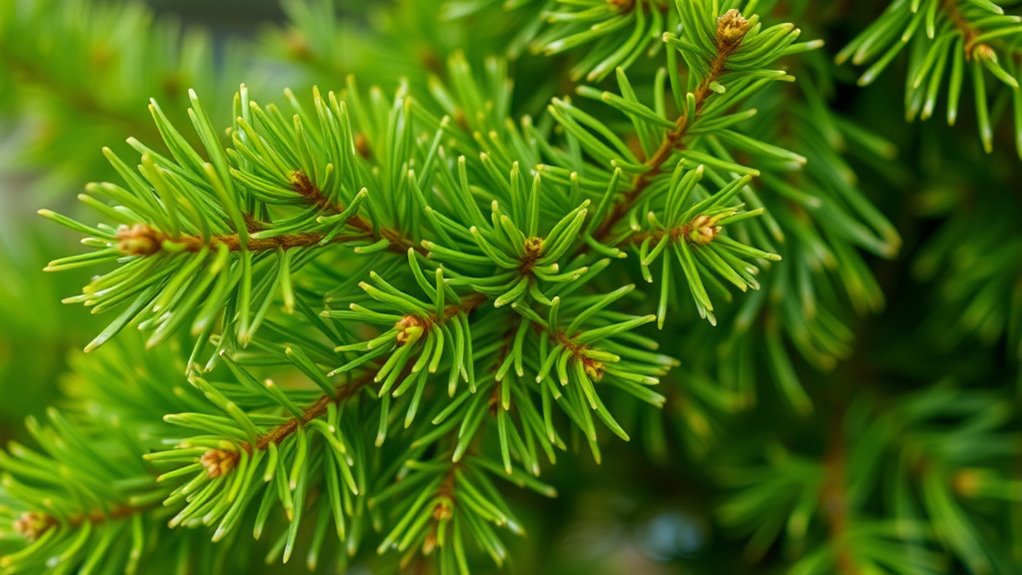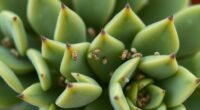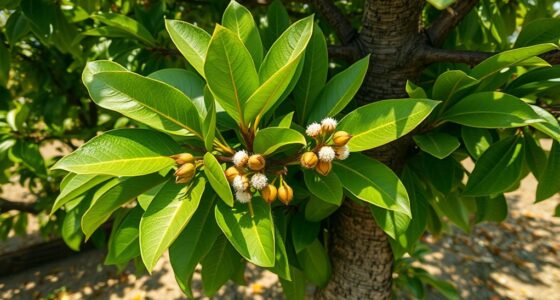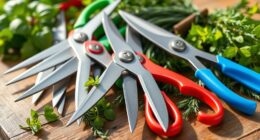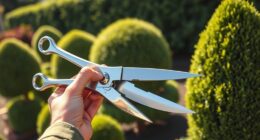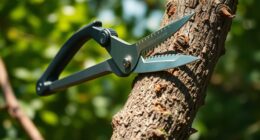If your Bird’s Nest spruce is turning brown, environmental stress, pests like spider mites or aphids, improper watering, or nutrient deficiencies could be causes. Check for pests, make certain consistent, deep watering, and verify soil health with testing. Mulching and pruning can help improve conditions, while treating pests and diseases can prevent further damage. By addressing these issues early, you can help your tree recover; exploring these steps will give you more ways to revive your spruce.
Key Takeaways
- Browning may result from pest infestations like spider mites or aphids damaging the foliage.
- Inconsistent watering or poor soil drainage can cause drought stress and root issues.
- Fungal diseases such as needle blight or rust can lead to premature browning of needles.
- Nutrient deficiencies or soil pH imbalances weaken the tree’s health, causing browning.
- Lack of proper pruning, mulching, and pest control can contribute to overall stress and browning.
Common Environmental Factors Leading to Browning
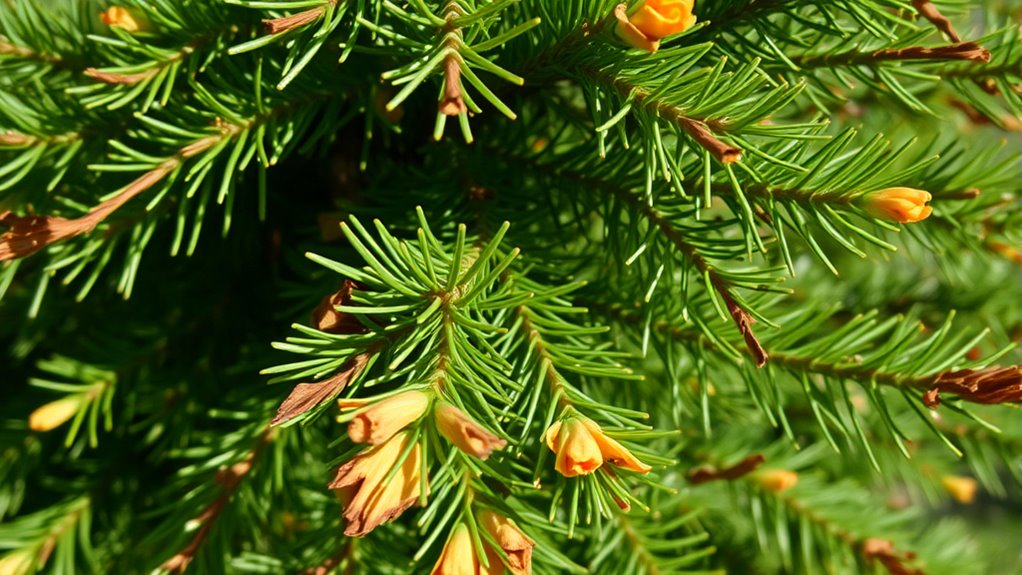
Environmental stressors are often the main cause of browning in your Bird’s Nest Spruce. Garden pests like spider mites or aphids can damage the foliage, causing the needles to turn brown and dry out. These pests thrive in stressful conditions, making your tree more vulnerable. These garden pests can quickly escalate if not managed promptly, further stressing the plant. Climate change also plays a significant role by creating unpredictable weather patterns, such as hot, dry spells or sudden temperature fluctuations, which stress the tree’s roots and needles. As a result, your Bird’s Nest Spruce may struggle to maintain healthy foliage. Being aware of these environmental factors helps you identify the problem early. Regular inspection and pest management, along with understanding climate impacts, can help you protect your tree from browning caused by these common environmental stressors. Essential oils for plant health can also support your efforts in maintaining a healthy, thriving tree. Additionally, **environmental factors** such as soil quality and water availability significantly influence the tree’s resilience against these stressors.
Watering Issues and Soil Conditions
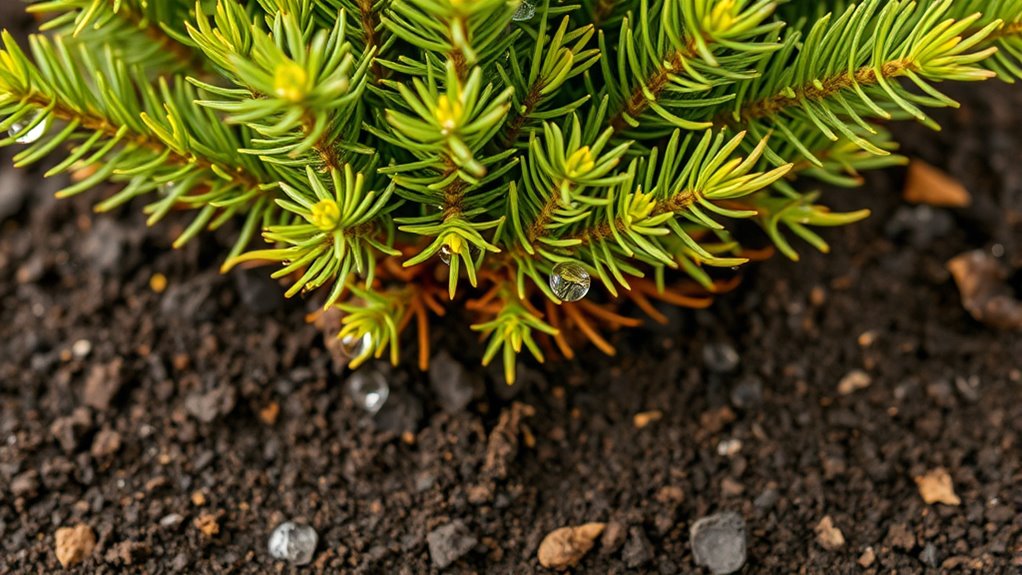
Inadequate or inconsistent watering can cause your Bird’s Nest Spruce to turn brown, as its roots struggle to absorb the moisture needed for healthy growth. To prevent this, ensure you water deeply and regularly, especially during dry spells. Proper soil conditions are vital: well-draining soil prevents root rot, while compacted soil hampers water absorption. Additionally, signs of spoilage such as discoloration can also indicate issues with plant health or watering practices. Consider these steps: 1. Use appropriate pruning techniques to remove dead or browning branches, improving airflow and light penetration. 2. Mulching benefits your tree by retaining soil moisture, regulating temperature, and reducing weeds. 3. Check soil moisture levels frequently to adjust watering schedules accordingly. Consistent watering and maintaining ideal soil conditions help keep your Bird’s Nest Spruce vibrant and healthy.
Pest Infestations and Disease Problems
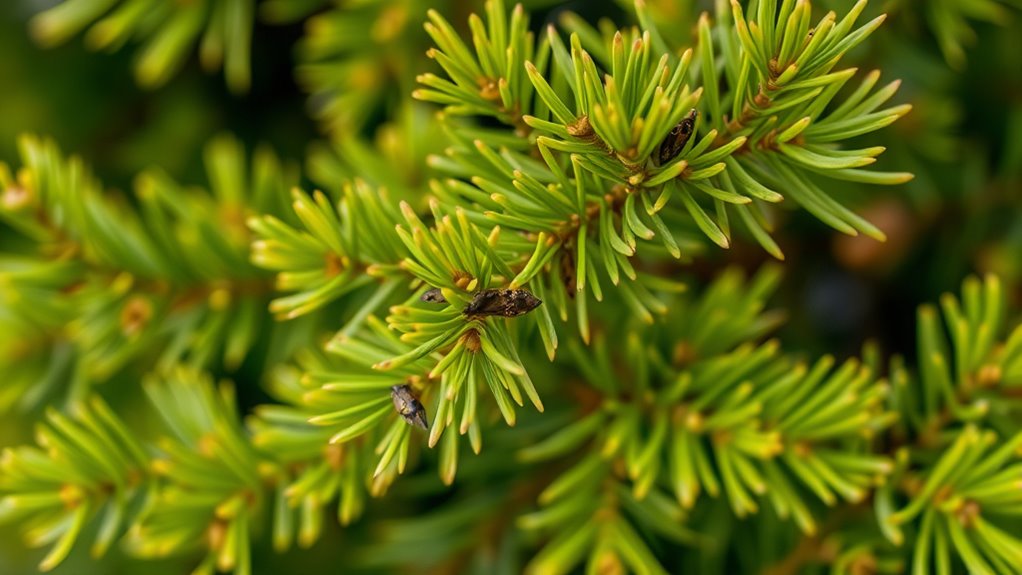
Pest infestations and disease problems can quickly threaten the health of your Bird’s Nest Spruce if left unchecked. Fungal infections, such as needle blight or rust, can cause your spruces to brown prematurely and weaken the overall structure. Insect damage from pests like aphids or spider mites can also sap nutrients, leading to browning and dieback. You might notice discolored or deformed needles, sticky residue, or visible pests on the foliage. Regularly inspect your tree for signs of infestation or infection, and address issues early. Applying appropriate fungicides or insecticides can help control these problems. Maintaining good airflow and avoiding overwatering also reduces the risk of fungal growth. Proper plant care and early intervention are vital for restoring your Bird’s Nest Spruce’s health. Additionally, understanding plant disease prevention techniques can help you avoid recurring issues and keep your tree vibrant. Being aware of Vetted products such as fungicides and insecticides can aid in selecting the most effective treatments.
Nutrient Deficiencies and Soil Imbalances
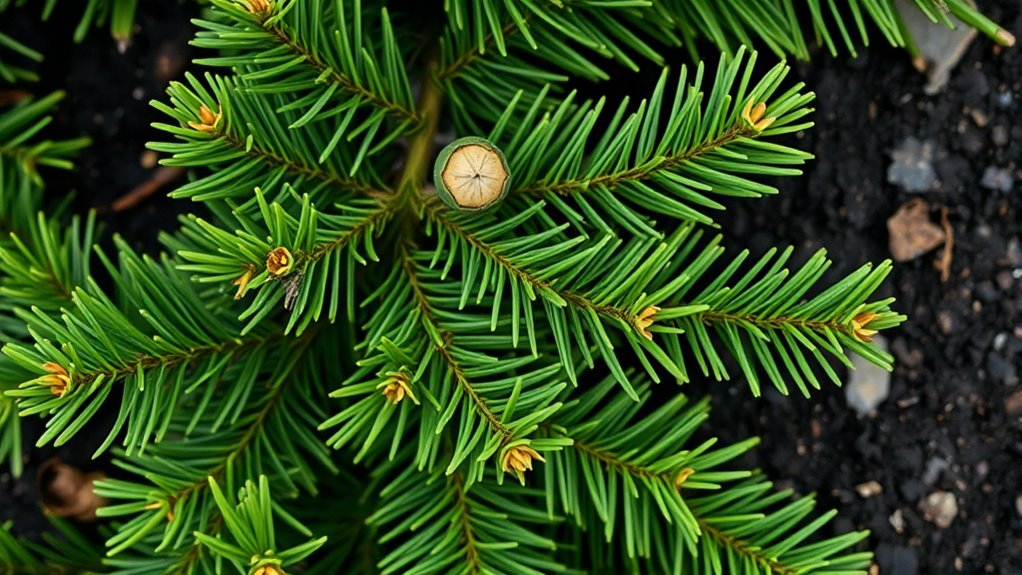
Even if pests and diseases are under control, your Bird’s Nest Spruce can still struggle with browning if its soil isn’t providing the right balance of nutrients. Nutrient deficiencies and soil imbalances are common causes. To address this, start with soil testing to identify missing nutrients or pH issues. Once you know what’s lacking, consider these steps:
Ensure healthy soil with testing and proper fertilization to prevent browning in your Bird’s Nest Spruce.
- Adjust fertilizer application to supply essential nutrients like nitrogen, phosphorus, and potassium.
- Amend the soil with organic matter or specific fertilizers based on test results.
- Regularly monitor soil health and re-test periodically to maintain proper nutrient levels.
- Understanding soil health is crucial for maintaining optimal plant growth and preventing issues like browning.
Proper soil management guarantees your spruce receives what it needs to stay healthy and vibrant, reducing browning caused by nutrient issues.
Proper Care and Maintenance to Restore Health
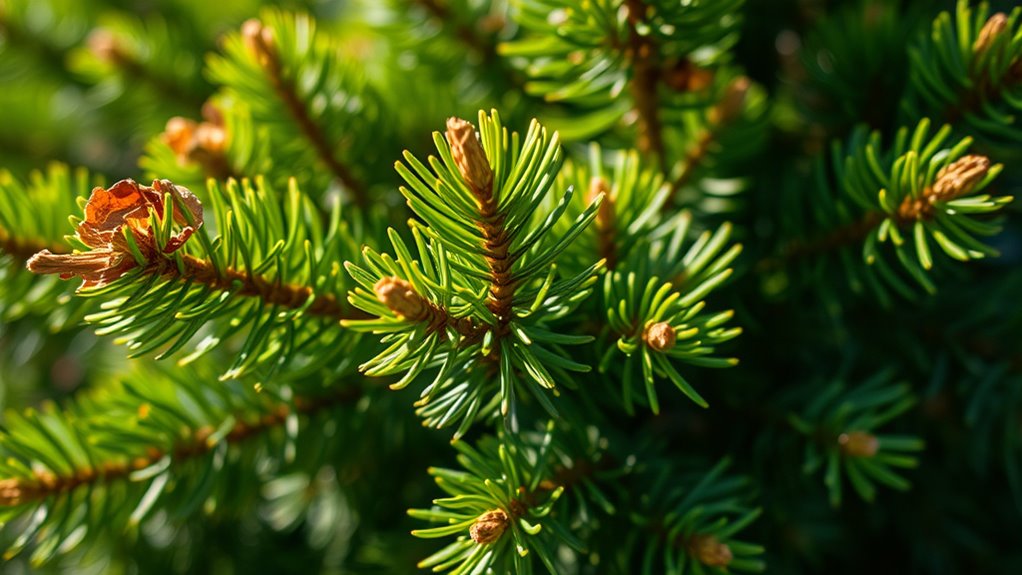
To restore your Bird’s Nest Spruce’s health, consistent care and maintenance are essential. Start by using proper pruning techniques to remove dead or brown branches, which encourages new growth and improves airflow. Be gentle and make clean cuts just above a healthy bud or branch junction. Mulching benefits your tree by conserving soil moisture, regulating temperature, and preventing weeds that compete for nutrients. Apply a layer of organic mulch around the base, keeping it a few inches away from the trunk. Regular watering is vital, especially during dry spells, but avoid overwatering. Also, monitor for pests or diseases and treat promptly. Incorporating proper watering techniques is crucial to ensure the soil remains moist but not waterlogged. Maintaining proper ventilation around your tree can help prevent disease and promote overall health. Consistent maintenance combined with attentive pruning and mulching will help your Bird’s Nest Spruce regain its lush, vibrant appearance.
Frequently Asked Questions
Can My Bird’S Nest Spruce Recover From Browning Without Pruning?
Yes, your bird’s nest spruce can recover from browning without pruning, thanks to natural recovery. If you address underlying issues like watering or pests, the plant may gradually bounce back. However, pruning benefits the process by removing dead or damaged branches, encouraging healthy growth. Keep an eye on conditions and give your tree proper care, and it might regain its vibrant appearance without the need for extensive pruning.
How Long Does It Typically Take to See Improvement After Fixing Issues?
You might worry about how long it takes to see improvement after fixing watering frequency and soil drainage issues. Usually, you’ll notice signs of recovery within a few weeks if you’ve corrected these problems promptly. Consistent watering and proper drainage help the plant rebound faster. Keep monitoring your bird’s nest spruce, and with patience, you should see new growth and greener foliage as it recovers from browning.
Are There Specific Signs Indicating a Pest Infestation Versus Environmental Stress?
You should look for pest symptoms like tiny webs, discolored spots, or visible insects on your bird’s nest spruce. Environmental cues include browning from drought, poor drainage, or sun scorch. If you notice small pests actively feeding or webbing, pests are likely the cause. Conversely, if the browning correlates with dry soil or harsh sunlight, environmental stress may be to blame. Identifying these signs helps determine the right fix.
Is Over-Fertilizing Harmful to Bird’S Nest Spruces?
Over-fertilizing can be a nightmare for your bird’s nest spruce, turning it into a wilted, sad shadow of its vibrant self. A fertilizer overdose causes nutrient imbalance, stressing the tree and leading to browning or needle drop. You should always follow recommended fertilizing guidelines, avoiding excess nutrients that harm your plant’s roots. Proper nutrition is key—too much can be just as damaging as too little.
Can Indoor Placement Cause My Bird’S Nest Spruce to Turn Brown?
Indoor placement can cause your bird’s nest spruce to turn brown due to indoor stress and inadequate light requirements. If it doesn’t get enough natural light, the plant struggles to produce energy, leading to browning needles. Guarantee your spruce is near a bright, indirect light source and avoid drafts or temperature fluctuations. Proper lighting and minimizing indoor stress will help your plant stay healthy and vibrant.
Conclusion
If your bird’s nest spruce is turning brown, don’t panic—you’re not alone in this battle against nature’s quirks. By understanding environmental stresses, watering habits, pests, and nutrient needs, you can breathe new life into your plant. With attentive care, you’ll see your tree bounce back faster than you can blink, transforming that sad, brown mess into a vibrant green masterpiece. Keep nurturing, and your spruce will thrive like a radiant green fortress once again.
